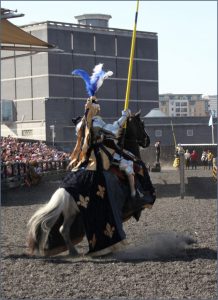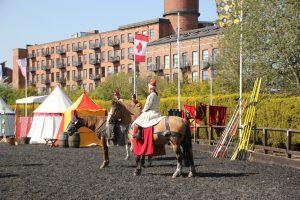The standards demanded of a medieval warhorse were enormous.
A destrier needed to be strong enough not only to carry a rider in full armour but also armour of their own. They needed to be large and sturdy enough to be able to withstand the chaos of battle and to potentially charge through the ranks of the enemy without breaking stride.  Yet they also needed to be fast and agile enough to be able to manoeuvre quickly. And, perhaps most crucially, they needed to have nerves of steel.
Yet they also needed to be fast and agile enough to be able to manoeuvre quickly. And, perhaps most crucially, they needed to have nerves of steel.
As a flight animal, i.e. one that would run away in the face of danger, most of these demands are unnatural to the horse. Charging at another being goes against all a horse’s natural instincts, with the noise of battle alone enough to trigger flight. Add to that lethal arrows dropping from the sky, sharp weapons cutting and stabbing all around them and bodies crashing into each other and you get a potent mix that would send any animal into a frenzied flight.
In light of these challenges, it seems an extraordinary feat to train efficient and deadly cavalry.
In spite of all the brutal looking bits and spurs and other riding implements of the medieval period, both horse and rider must have been exceptionally well-trained. A horse was a knight’s life-insurance (and worth huge sums of money), so they had to be reliable.
Modern jousters know this as well as any medieval knight did. Some horses are just not the right “person” for the job, some might only cope with it for a season before they refuse to ever charge again. The horse must be mentally and physically able to comply with the high demands of war and tournament.
Cold-blooded horses, for example a Percheron or Suffolk Punch, tend to be not only sturdy, strong animals but also have a much calmer disposition than a temperamental thoroughbred. That is not to say that the latter are unsuitable for war, and there is plenty of evidence of the contrary. However, they are more suited to a very different style of fighting on horseback as employed by various Near Eastern and Eastern European peoples for example.
For the classic medieval Western European style on the other hand, relying heavily on strength and force, a horse more reminiscent of a modern cob or light cold blood was needed.
The Warhorse Project’s aim is to trace these very horses across medieval Europe, from their physical development to their training and usage. Understanding where, when and how medieval warhorses emerged and evolved will shed more light on military transitions and associated social changes such as the development of chivalry.